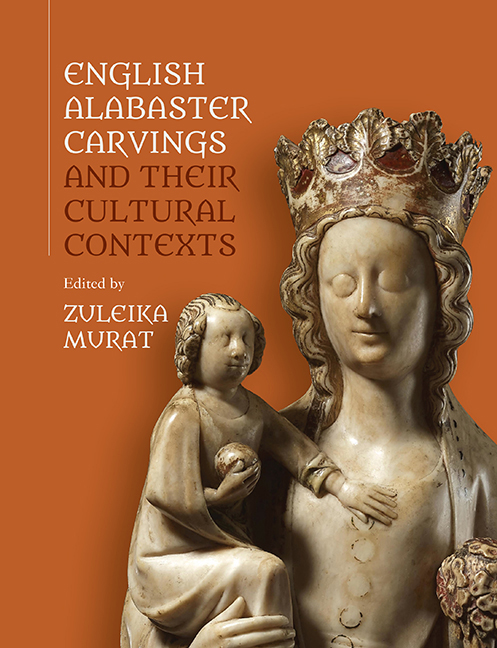Book contents
- Frontmatter
- CONTENTS
- List of Illustrations
- Acknowledgements
- List of Contributors
- Introduction
- 1 ‘Burton-Upon-Trent, Not Nottingham.’ the Evolving Study Of Medieval English Alabaster Sculpture
- 2 Stone to Ensure Victory and to Generate Friendships. On The Meaning of Alabaster
- 3 Contextualising English Alabasters in the Material Culture of the Medieval Mediterranean
- 4 English Alabaster Images As Recipients of Music in the Long Fifteenth Century: English Sacred Traditions in a European Perspective
- 5 Contextualising Alabasters in Their Immersive Environment. The ‘Ancona D'Allabastro Di Diverse Figure’ of the Novalesa Abbey: Meaning and Function
- 6 Alabaster Carvings in Late-Medieval Lincolnshire
- 7 ‘Tabernacles, Howsynges and Other Things’. Three Alabasters From the Burrell Collection in Context
- 8 Conservation Study of Three Alabaster Carvings From the Burrell Collection, Glasgow Museums
- 9 ‘Smooth as Monumental Alabaster’. the Alabaster Tomb Industry in England 1550–1660
- 10 Merchants’ Tombs in Alabaster
- 11 Exploring Alice: the Theological, Socio-Historical, and Anatomical Context of the De La Pole Cadaver Sculpture
- Bibliography
- Index
- Already Published
4 - English Alabaster Images As Recipients of Music in the Long Fifteenth Century: English Sacred Traditions in a European Perspective
Published online by Cambridge University Press: 14 September 2019
- Frontmatter
- CONTENTS
- List of Illustrations
- Acknowledgements
- List of Contributors
- Introduction
- 1 ‘Burton-Upon-Trent, Not Nottingham.’ the Evolving Study Of Medieval English Alabaster Sculpture
- 2 Stone to Ensure Victory and to Generate Friendships. On The Meaning of Alabaster
- 3 Contextualising English Alabasters in the Material Culture of the Medieval Mediterranean
- 4 English Alabaster Images As Recipients of Music in the Long Fifteenth Century: English Sacred Traditions in a European Perspective
- 5 Contextualising Alabasters in Their Immersive Environment. The ‘Ancona D'Allabastro Di Diverse Figure’ of the Novalesa Abbey: Meaning and Function
- 6 Alabaster Carvings in Late-Medieval Lincolnshire
- 7 ‘Tabernacles, Howsynges and Other Things’. Three Alabasters From the Burrell Collection in Context
- 8 Conservation Study of Three Alabaster Carvings From the Burrell Collection, Glasgow Museums
- 9 ‘Smooth as Monumental Alabaster’. the Alabaster Tomb Industry in England 1550–1660
- 10 Merchants’ Tombs in Alabaster
- 11 Exploring Alice: the Theological, Socio-Historical, and Anatomical Context of the De La Pole Cadaver Sculpture
- Bibliography
- Index
- Already Published
Summary
PROLOGUE: ETON COLLEGE, CIRCA 1480
From at least around 1480 – but probably also from much closer to the beginnings of Henry VI's college in the 1440s (the official foundation was in 1440, a year before that of King's College, Cambridge), – every evening after Vespers and Compline the singing men and choristers of Eton chapel processed down from their stalls in the chancel to a position below the rood screen, in a space open and accessible to the public. Here, a devotional action (the so-called ‘Salve ceremony’) was performed in honour of the Blessed Virgin, in front of her sculpted image (Our Lady of Eton). Music and intercession alike were directed, in principle and also in physical fact, towards this statue. The musical settings functioned as direct greetings and eulogies to Mary, the sculpture marking (physically) her sacred presence. Ceremony and devotion were material and spiritual at the same time.
In this way, the statue of Mary and the Marian music were spatially and psychologically connected – and, moreover, all bystanders were in theory made welcome for the sequence of short prayers and devotional texts that were chanted and recited at this event. The texts were preceded and/or followed by a polyphonic votive antiphon, a sophisticated and sometimes richly elaborate musical genre which enjoyed the greatest imaginable popularity in the later Middle Ages in many types of institutions and choral foundations, as well as in smaller churches. This type of votive event was thus an important point of access to art and music, in a devotional context, for the general, non-clerical public.
This scene – of a shared moment of ‘poetic’ devotion and ceremony, (re) enacted day by day in front of a revered cultic statue, and performed with music and lighting of technical and aesthetic sophistication – was both special (in its poetry and beauty) and ordinary (in its regularity). It may stand as an illustrative and perhaps emblematic prologue to the present study. It was a type of scene that was repeated all over England, indeed all over Catholic Europe, from the fourteenth through to the sixteenth century, in a variety of ways and styles.
- Type
- Chapter
- Information
- English Alabaster Carvings and their Cultural Contexts , pp. 93 - 126Publisher: Boydell & BrewerPrint publication year: 2019

